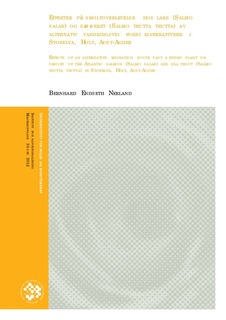Effekter på smoltoverlevelse hos laks (Salmo salar) og sjøørret (Salmo trutta trutta) av alternativ vandringsvei forbi elvekraftverk i Storelva, Holt, Aust-Agder
Master thesis
Permanent lenke
http://hdl.handle.net/11250/186931Utgivelsesdato
2013-03-22Metadata
Vis full innførselSamlinger
- Master's theses (INA) [593]
Sammendrag
En stor andel av anadrome vassdrag i Norge er utbygde for vannkraftformål. Dette skaper
problemer for både oppvandrende gytefisk og nedvandrende smolt. Man vet forholdsvis lite
om hva som er effekten av at smolt må vandre gjennom turbiner og hva som kan være bedre
løsninger for disse. Formålet med dette masterprosjektet var å dokumentere effektene en
eksisterende utvandringsvei gjennom et turbinløp og en ny, alternativ nedvandringsvei
utformet som en kunstig foss, hadde på lakse- og ørretsmoltens overlevelse nedover et
vassdrag. I løpet av våren 2011 ble det PIT-merket totalt 533 smolt som del av et merkegjenfangstforsøk
i Storelva i Holt, Aust-Agder. Av disse utgjorde ca. 32 % ørret og 68 % laks.
Hvilken nedvandringsvei som ble valgt viste seg å avhenge av vanntemperatur ved
igangsettingen av vandringen, samt utforming av og vannmengde ut den alternative
nedvandringsveien ”sideløpet”. Det viste seg at smolt av begge arter generelt hadde en høyere
sannsynlighet for å velge sideløpet over turbinløpet, noe som forklares ut i fra en ideell
plassering i overflatelaget med hensyn til til turbininntaket og utforming med tanke på
kapasiteten til å frigjøre store mengde vann og dermed skape tiltrekkende overflatestrømmer.
Det ble i tillegg oppdaget at overlevelsen gjennom turbinløpet var størrelsesavhengig, noe
som over kort tid kan føre til en seleksjon av smolt av mindre størrelse, som igjen vil redusere
marin overlevelse. Funnene i dette MSc-prosjektet kan ha høy relevans for andre anadrome
systemer med regulering, og kanskje spesielt systemer med flere kraftverkdemninger langs
lakseførende strekning. Hydroelectric power dams constitute major obstacles to upstream and downstream migration
for anadromous fish. The downstream part of this has received little attention and little is
known about the individual and population level consequences from forcing migratory smolt
through hydropower turbines. During spring 2011 a total of 533 salmon and trout smolt were
PIT tagged as part of a mark-recapture experiment in Storelva in Holt, Aust-Agder County,
with the aim of quantifying the survival consequences from swimming through turbines as
compared to an alternative route. The relative contribution to downstream migration of the
two routes was also evaluated. Of these smolt salmon and sea trout constituted approximately
68 % and 32 % respectively. The choice of migration route greatly depended on water
temperature at the initiation of migration, as well as the design and water flow out of the
alternate migration route. It was observed that smolt of both species had a higher probability
of choosing the alternate route over the turbine route, which can be explained on the basis of
an ideal location (surface water) in relation to the turbine inlet and the design in terms of the
capacity to release large amounts of water and thus creating attractive surface currents for the
fish. It was discovered that survival through the turbine was negatively size-dependent, which
over short time could lead to selection against larger smolt, which may further reduce marine
survival. It was concluded that provided correct location of alternate routes, i.e. located close
to the turbine inlet and close to the surface, migrating smolt may successfully be guided into
less harmful migration routes and hence increase smolt survival and quality.
